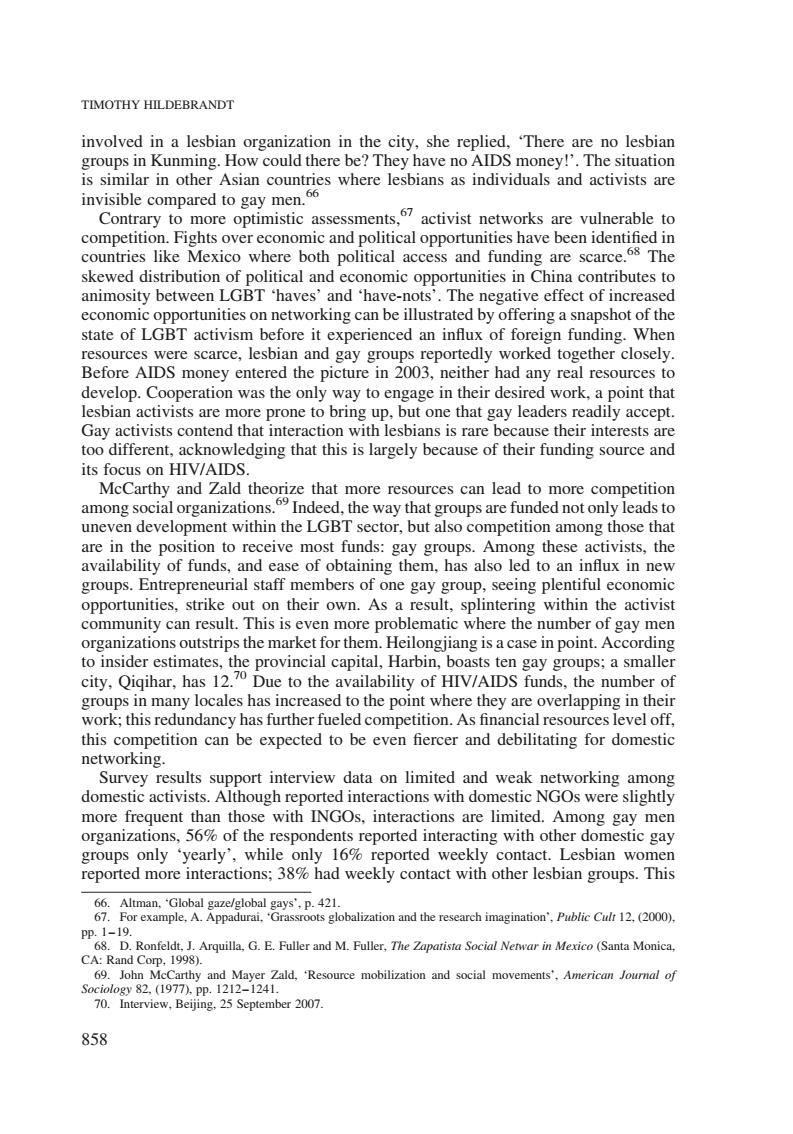正在加载图片...

TIMOTHY HILDEBRANDT involved in a lesbian organization in the city,she replied,'There are no lesbian groups in Kunming.How could there be?They have no AlDS money!'.The situation is similar in other Asian countries where lesbians as individuals and activists are invisible compared to gay men.66 Contrary to more optimistic assessments,7 activist networks are vulnerable to competition.Fights over economic and political opportunities have been identified in countries like Mexico where both political access and funding are scarce.68 The skewed distribution of political and economic opportunities in China contributes to animosity between LGBT 'haves'and 'have-nots'.The negative effect of increased economic opportunities on networking can be illustrated by offering a snapshot of the state of LGBT activism before it experienced an influx of foreign funding.When resources were scarce,lesbian and gay groups reportedly worked together closely. Before AIDS money entered the picture in 2003,neither had any real resources to develop.Cooperation was the only way to engage in their desired work,a point that lesbian activists are more prone to bring up,but one that gay leaders readily accept. Gay activists contend that interaction with lesbians is rare because their interests are too different,acknowledging that this is largely because of their funding source and its focus on HIV/AIDS. McCarthy and Zald theorize that more resources can lead to more competition among social organizations.Indeed,the way that groups are funded not only leads to uneven development within the LGBT sector,but also competition among those that are in the position to receive most funds:gay groups.Among these activists,the availability of funds,and ease of obtaining them,has also led to an influx in new groups.Entrepreneurial staff members of one gay group,seeing plentiful economic opportunities,strike out on their own.As a result,splintering within the activist community can result.This is even more problematic where the number of gay men organizations outstrips the market for them.Heilongjiang is a case in point.According to insider estimates,the provincial capital,Harbin,boasts ten gay groups;a smaller city,Qiqihar,has 12.70 Due to the availability of HIV/AIDS funds,the number of groups in many locales has increased to the point where they are overlapping in their work;this redundancy has further fueled competition.As financial resources level off, this competition can be expected to be even fiercer and debilitating for domestic networking. Survey results support interview data on limited and weak networking among domestic activists.Although reported interactions with domestic NGOs were slightly more frequent than those with INGOs,interactions are limited.Among gay men organizations,56%of the respondents reported interacting with other domestic gay groups only 'yearly',while only 16%reported weekly contact.Lesbian women reported more interactions;38%had weekly contact with other lesbian groups.This 66.Altman,'Global gaze/global gays',p.421. 67.For example,A.Appadurai.'Grassroots globalization and the research imagination',Public Cult 12,(2000). Pp.1-19. 68.D.Ronfeldt.J.Arquilla.G.E.Fuller and M.Fuller.The Zapatista Social Nenwar in Mexico (Santa Monica. CA:Rand Corp,1998). 69.John McCarthy and Mayer Zald,'Resource mobilization and social movements',American Journal of Sociology82,(1977),Pp.1212-1241. 70.Interview,Beijing,25 September 2007. 858involved in a lesbian organization in the city, she replied, ‘There are no lesbian groups in Kunming. How could there be? They have no AIDS money!’. The situation is similar in other Asian countries where lesbians as individuals and activists are invisible compared to gay men.66 Contrary to more optimistic assessments,67 activist networks are vulnerable to competition. Fights over economic and political opportunities have been identified in countries like Mexico where both political access and funding are scarce.68 The skewed distribution of political and economic opportunities in China contributes to animosity between LGBT ‘haves’ and ‘have-nots’. The negative effect of increased economic opportunities on networking can be illustrated by offering a snapshot of the state of LGBT activism before it experienced an influx of foreign funding. When resources were scarce, lesbian and gay groups reportedly worked together closely. Before AIDS money entered the picture in 2003, neither had any real resources to develop. Cooperation was the only way to engage in their desired work, a point that lesbian activists are more prone to bring up, but one that gay leaders readily accept. Gay activists contend that interaction with lesbians is rare because their interests are too different, acknowledging that this is largely because of their funding source and its focus on HIV/AIDS. McCarthy and Zald theorize that more resources can lead to more competition among social organizations.69 Indeed, the way that groups are funded not only leads to uneven development within the LGBT sector, but also competition among those that are in the position to receive most funds: gay groups. Among these activists, the availability of funds, and ease of obtaining them, has also led to an influx in new groups. Entrepreneurial staff members of one gay group, seeing plentiful economic opportunities, strike out on their own. As a result, splintering within the activist community can result. This is even more problematic where the number of gay men organizations outstrips the market for them. Heilongjiang is a case in point. According to insider estimates, the provincial capital, Harbin, boasts ten gay groups; a smaller city, Qiqihar, has 12.70 Due to the availability of HIV/AIDS funds, the number of groups in many locales has increased to the point where they are overlapping in their work; this redundancy has further fueled competition. As financial resources level off, this competition can be expected to be even fiercer and debilitating for domestic networking. Survey results support interview data on limited and weak networking among domestic activists. Although reported interactions with domestic NGOs were slightly more frequent than those with INGOs, interactions are limited. Among gay men organizations, 56% of the respondents reported interacting with other domestic gay groups only ‘yearly’, while only 16% reported weekly contact. Lesbian women reported more interactions; 38% had weekly contact with other lesbian groups. This 66. Altman, ‘Global gaze/global gays’, p. 421. 67. For example, A. Appadurai, ‘Grassroots globalization and the research imagination’, Public Cult 12, (2000), pp. 1 –19. 68. D. Ronfeldt, J. Arquilla, G. E. Fuller and M. Fuller, The Zapatista Social Netwar in Mexico (Santa Monica, CA: Rand Corp, 1998). 69. John McCarthy and Mayer Zald, ‘Resource mobilization and social movements’, American Journal of Sociology 82, (1977), pp. 1212–1241. 70. Interview, Beijing, 25 September 2007. TIMOTHY HILDEBRANDT 858